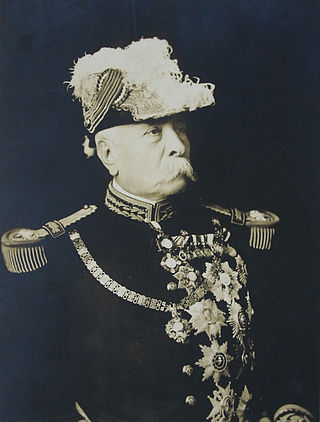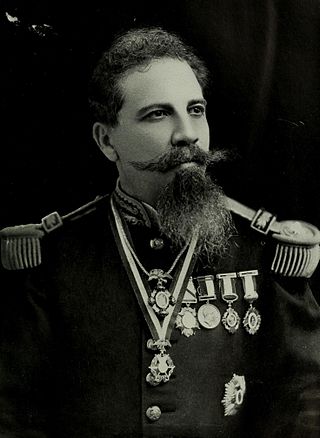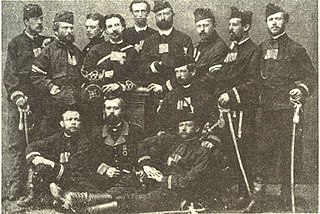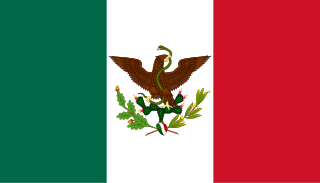
José de la Cruz Porfirio Díaz Mori, was a Mexican general and dictator who served on three separate occasions as President of Mexico, a total of over 30 years, from 28 November 1876 to 6 December 1876, 17 February 1877 to 1 December 1880, and 1 December 1884 to 25 May 1911. The period from 1876 to 1911 is often referred to as the Porfiriato, and has been called a de facto dictatorship.

Benito Pablo Juárez García was a Mexican politician, military commander, and lawyer who served as the 26th president of Mexico from 1858 until his death in office in 1872. A Zapotec, he was the first Indigenous president of Mexico and the first democratically elected Indigenous president in the postcolonial Americas. A member of the Liberal Party, he previously held a number of offices, including the governorship of Oaxaca and the presidency of the Supreme Court. During his presidency, he led the Liberals to victory in the Reform War and in the Second French intervention in Mexico.

Manuel del Refugio González Flores was a Mexican military general and liberal politician who served as the 35th President of Mexico from 1880 to 1884.

Bernardo Doroteo Reyes Ogazón was a Mexican general and politician who fought in the Second French intervention in Mexico and served as the appointed Governor of Nuevo León for more than two decades during the Porfiriato. During Reyes's administration as Governor, the state made important economic, industrial and social advances, and he was one of the closest and most faithful allies of President of Mexico Porfirio Díaz. He was killed during a failed coup d'état against President Francisco I. Madero in the first stage of the Mexican Revolution.

The second French intervention in Mexico, also known as the Second Franco-Mexican War (1861–1867), was a military invasion of the Republic of Mexico by the French Empire of Napoleon III, purportedly to force the collection of Mexican debts in conjunction with Great Britain and Spain. Mexican conservatives supported the invasion, since they had been defeated by the liberal government of Benito Juárez in a three-year civil war. Defeated on the battlefield, conservatives sought the aid of France to effect regime change and establish a monarchy in Mexico, a plan that meshed with Napoleon III's plans to re-establish the presence of the French Empire in the Americas. Although the French invasion displaced Juárez's Republican government from the Mexican capital and the monarchy of Archduke Maximilian was established, the Second Mexican Empire collapsed within a few years. Material aid from the United States, whose four-year civil war ended in 1865, invigorated the Republican fight against the regime of Maximilian, and the 1866 decision of Napoleon III to withdraw military support for Maximilian's regime accelerated the monarchy's collapse.

Juan Nepomuceno Laureano Méndez Sánchez was a Mexican general, a Liberal politician and confidant of Porfirio Díaz, and interim president of the Republic for a few months during the Porfiriato. He served from 6 December 1876 until 17 February 1877.

José Cevallos Cepeda was a Mexican politician and military leader.

Diódoro Corella was a Mexican general and the Governor of San Luis Potosí from 1872 to 1873. Corella was a liberal and strongly opposed French Intervention in Mexico, being exiled by the conservative government. He returned to Mexico upon the victory of Benito Juárez and fought against Porfirio Díaz when he tried to seize power. In 1871, he fought against the Uprising of Tamaulipas, and in 1872, he headed a cavalry division with the rank of colonel general and then brigade general; that year he fought Jerónimo Treviño's forces in the Battle of Monterrey with, according to Juan E. Guerra, 4,000 men. In early 1876, he was in Santo Domingo Yanhuitlán suppressing the Revolution of Tuxtepec, a second uprising by Díaz, and on 2 June, he was reported as wounded from battle. His remains were interred on 17 July 1876 at the Rotunda of Illustrious Persons.

The Battle of Miahuatlán took place on 3 October 1866 in the vicinity of the current municipality of Miahuatlán de Porfirio Díaz in the state of Oaxaca, Mexico. It was fought between elements of the Mexican republican army under General Porfirio Díaz and troops of the Second Mexican Empire during the Second French intervention in Mexico.

Luis Pérez Figueroa was a Mexican general who fought in the war of independence that followed the French intervention in Mexico.

The Battle of 2 de Abril was fought on April 2, 1867, in and around the city of Puebla, Puebla. It was one of the major military actions in the Franco-Mexican War between elements of the Mexican Army of the Republic commanded by General Porfirio Díaz and troops in the service of the Mexican Empire composed of Mexican imperialist soldiers.

The Battle of Acapulco were a series of battles during the Second French intervention in Mexico. Acapulco was a key port of the Pacific trade routes and thus changed hands several times in the course of the Franco-Mexican war. In this period the population of the city had decreased from 6000 to 2000.

The Battle of Barranca Seca was a battle of the Second French intervention in Mexico and took place right after the Battle of Puebla on 18 May 1862. Contrary to the latter it was won by the unified reactionist Mexican-French forces. The battle was preceded by a coup de chef of the reactionist forces, which was heated by the intrigue of the Spanish high command against Almonte and Márquez and French pressure towards the replacement of Zuloaga. After the battle Almonte remained the only contender for the Commander-in-Chief office within the reactionist party and Márquez as acting General; both of them serving French interests.

The Battle of San Juan Bautista was a battle in the Second French intervention in Mexico fought on February 27, 1864. Mexican Republicans were victorious and retook control of the city. The Republican forces consisted only of the Tabasquian militia from the surrounding areas ranging between 300 and 1,100 men, only half of whom were equipped with firearms the others fought with machetes.

The siege of Mexico City was an 1867 military engagement in the Second French intervention in Mexico between Republican forces, aided by the United States, and Emperor Maximilian's troops, aided by the French Empire and Austria-Hungary, encompassing in the siege of the city. It was the last armed conflict of the Second Mexican Empire and the fall of the city resulted in the transition of the Empire into the Republic led by Benito Juárez.
The Batalle of la Loma was a minor engagement of the Second French intervention in Mexico which took place on 16 July 1865 in the vicinity of Hacienda de la Loma in the current municipality of Tacámbaro, Michoacán. The battle occurred members of the Mexican Republican army, led by General Porfirio Díaz, and the Belgian Legion, supporting French and Mexican Imperial troops, led by Lieutenant Colonel Alfred Van der Smissen. Despite the Belgian victory, the Mexican mission was highly expensive for Belgium because just half of 1,500 soldiers sent to Mexico returned to Europe at the end of the war.

The Restored Republic was the era of Mexican history between 1867 and 1876, starting with the liberal triumph over the Second French Intervention in Mexico and the fall of the Second Mexican Empire and ending with Porfirio Diaz's ascension to the presidency. It was followed by the three-decade dictatorship known as the Porfiriato.

José María Cayetano Arteaga Magallanes was a prominent Mexican politician and general who served in the Mexican–American War, the Reform War and the Second French intervention in Mexico. Executed by Imperial forces during that invasion, Arteaga was recognized as one of the Martyrs of Uruapan.

José Miguel Pascual Negrete Novoa, commonly known as Miguel Negrete was a 19th-century Mexican Major General. He participated in the many Mexican Civil Wars, as well as the Mexican–American War and the Second French intervention in Mexico. Negrete was also the Governor of Puebla from October 13, 1863, to November 4, 1863, and the Minister of War and Navy of Mexico from March 16, 1864 to August 23, 1865.

Tomás Antonio Ignacio O'Horán y Escudero (1819-1867) was an Imperial Mexican general of Irish descent during the Second French intervention in Mexico. He was known for switching sides during the war as he initially sided with Benito Juárez but after the Siege of Mexico City, O'Horán was executed.



















